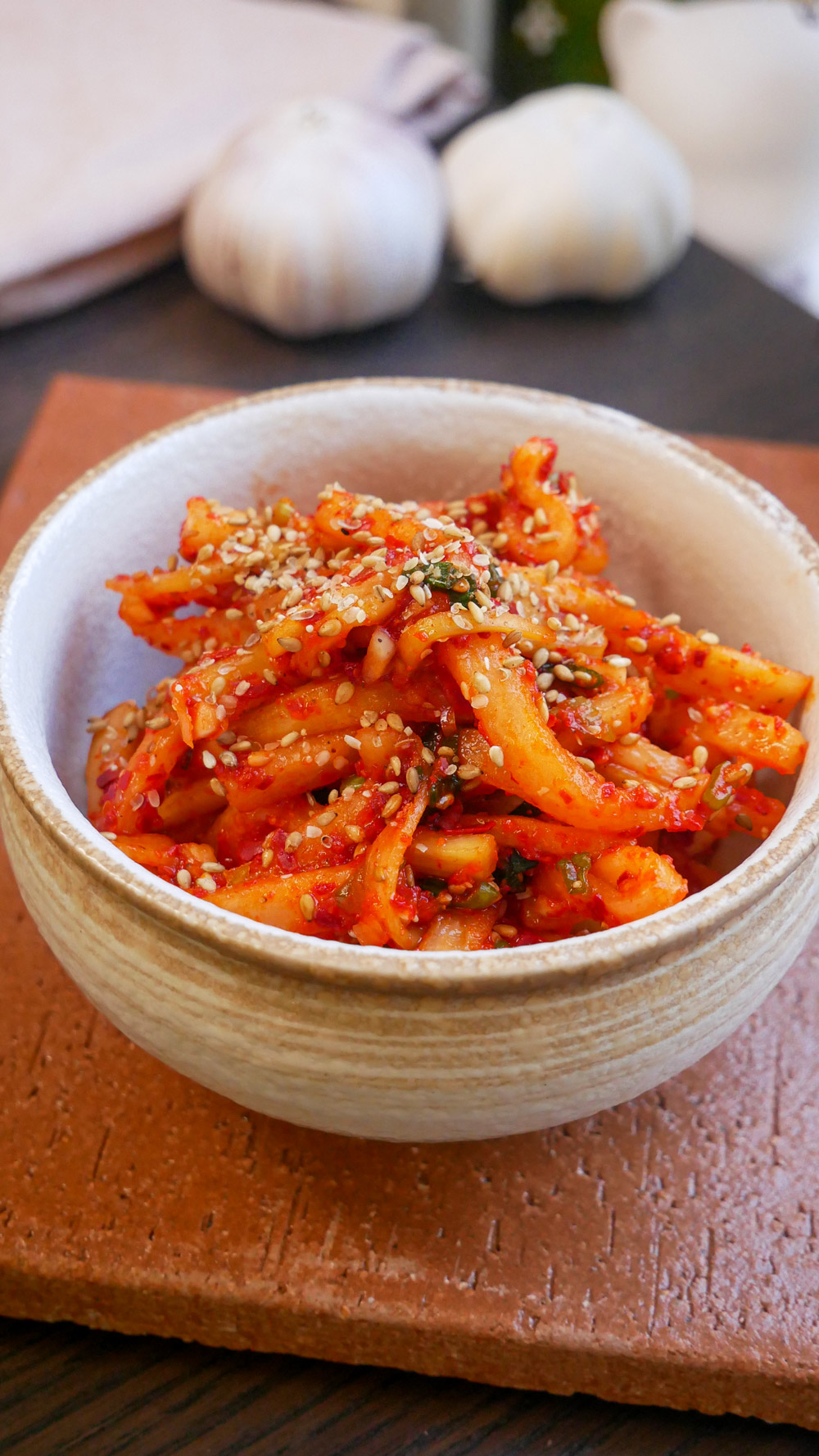Musaengchae is a spicy Korean salad made of julienned Korean radish called ‘mu’ that’s seasoned with a blend of spices, aromatics, and umami-packed ingredients. It’s a staple in Korean cuisine and happens to be one of my favorite ban chan (or side dishes)!
This radish salad is usually enjoyed alongside main courses and is most commonly served with Bossam, which is Korean Boiled Pork Belly. Whether you’re having this with a simple bowl of rice or an elaborate meal like bossam, this Korean radish salad is guaranteed to hit the spot!
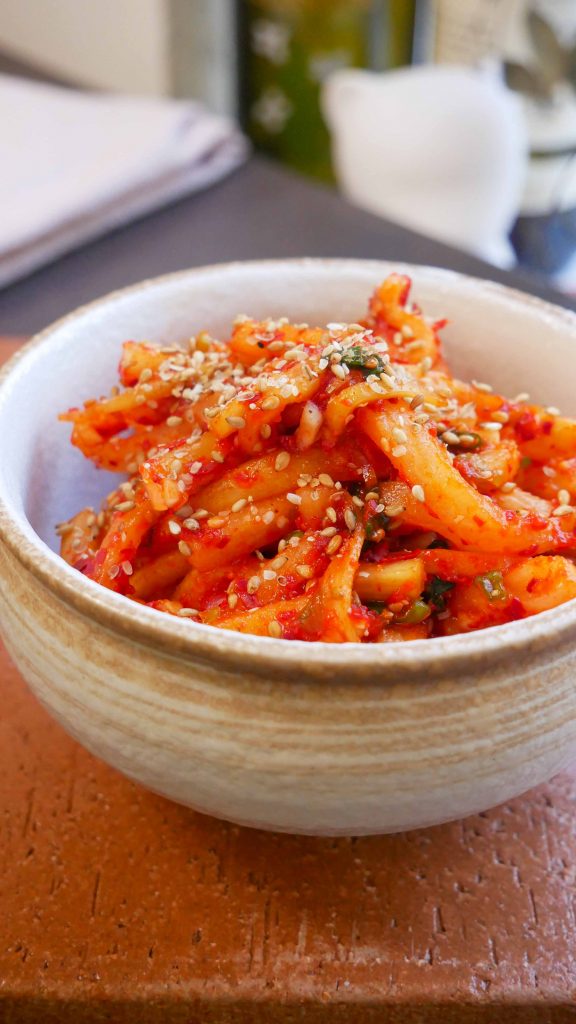
What you’ll love about this recipe
If you’re looking for a side dish that has a delicious combination of vibrant flavors and crunchy textures, this Korean radish salad is for you. The radish adds a delightful crispness which is complemented by the flavorful spicy seasoning. Not only is it incredibly crunchy and refreshing, it requires minimal ingredients and effort to prepare. Everything comes together in just 20 minutes!
I love making a big batch of this side dish and keeping it stored in my fridge to enjoy as a quick side dish to complete my meals. Plus, the longer it sits, the more flavorful it becomes!
Now, this dish is best when made with Korean radish called ‘mu’. Korean radish is typically shorter and rounder with light green skin on one end that fades to white. In terms of flavor, it has a mild taste with a subtle hint of sweetness and pepperiness. Additionally, Korean radish has a crisp texture when raw and is denser and crunchier than other radish like daikon. I highly recommend using Korean radish for this recipe however, daikon radish is a good alternative. The flavors of the radish will be a bit milder but will still be delicious!
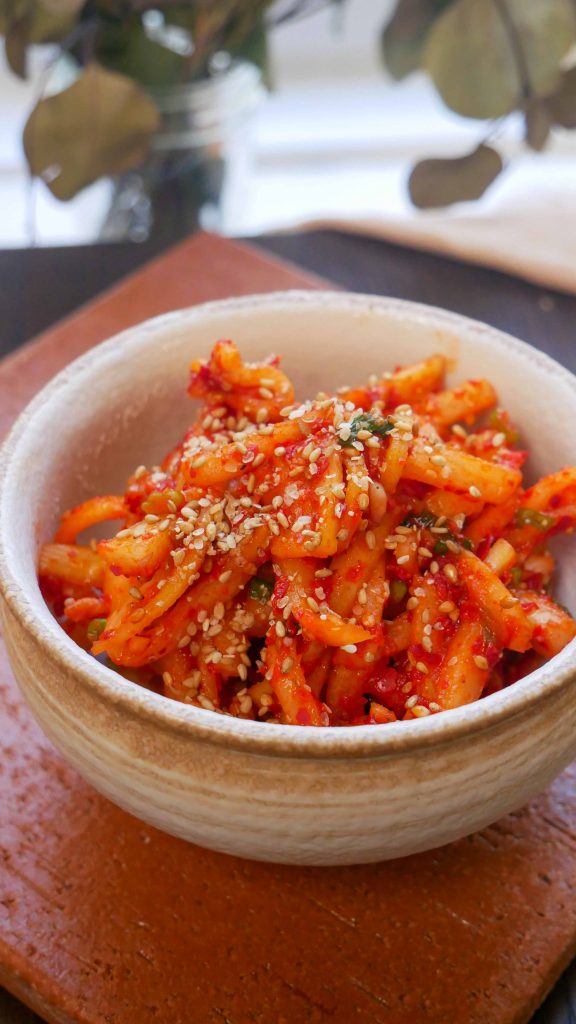
Korean Radish Salad Ingredients & Substitutions
Korean radish: I like to use Korean radish because it has a better capability to hold its crunch than other types of radishes. It’s also slightly more peppery and flavorful. However, you can substitute this with daikon radish if you prefer a milder flavor or it’s the only radish you have access to.
Salt: Salt is used to ‘sweat’ the radish which essentially helps to draw out excess moisture. Removing excess moisture helps the radishes stay crunchy, prevents the salad from turning watery, and mellows down the peppery flavor of the radish.
Sugar: Also helps to draw out excess moisture from the radish and enhances its natural sweetness
Garlic: Packs a ton of pungent garlicky flavors and aromas to the radish salad. Feel free to add more but not less!
Scallion: Adds a slight oniony flavor and freshness
Fish sauce: For saltiness and umami
Gochugaru (Korean red pepper flakes): Added for spice! This also adds a nice red color to the dish. I recommend using coarse gochugaru. The spiciness can be modified by adjusting the amount of gochugaru added.
White vinegar: For slight acidity to balance out the saltines. It also helps prolong the shelf life of the salad.
Toasted sesame seeds: For garnish, added crunch, and nutty flavor
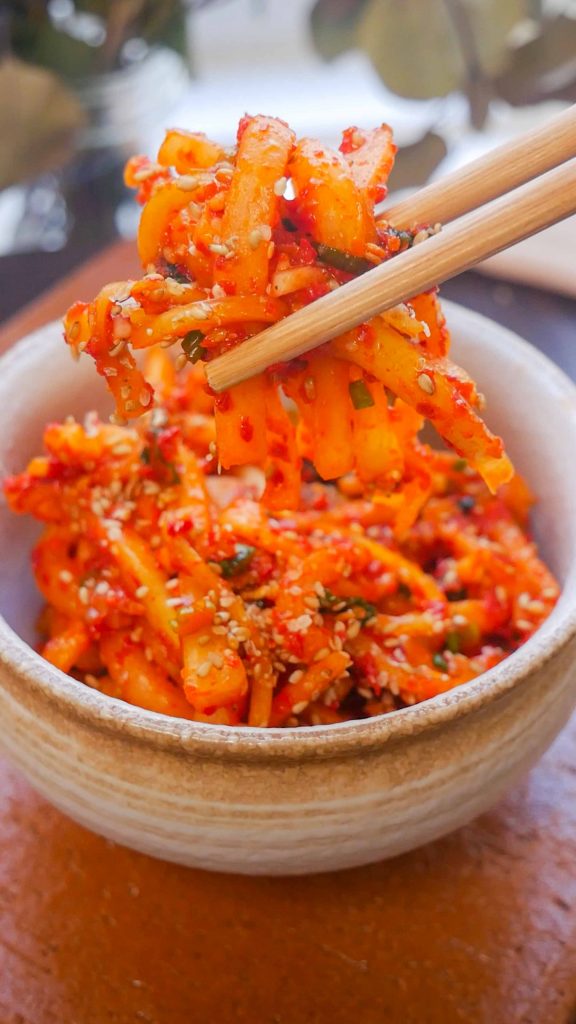
How to Prepare Korean Radish Salad
Step 1: Prepare the radish
Wash and peel the Korean radish. Slice them into thin matchsticks, about 1/4 inch thick.

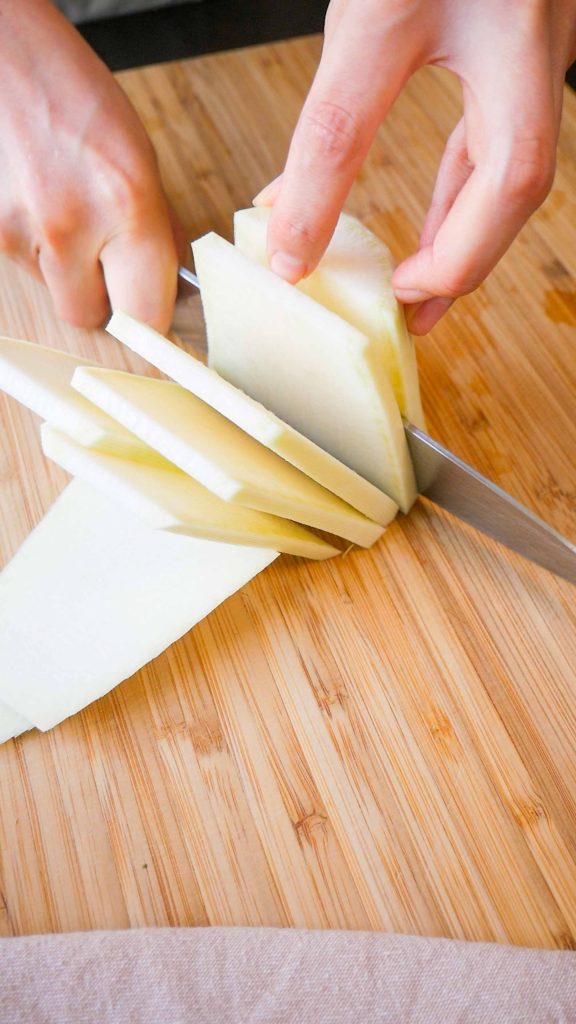
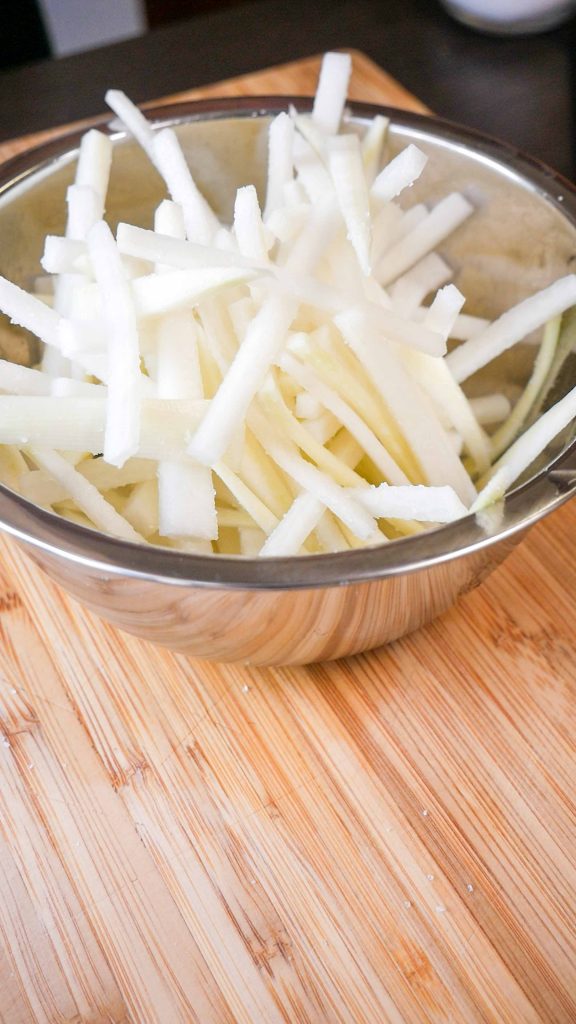
Step 2: Combine the radish in salt and sugar
Transfer the radish into a small mixing bowl. Add 1 teaspoon salt and 1 teaspoon sugar. Toss to combine well. Set aside for 15 minutes.

Step 3: Squeeze the radish
After 15 minutes, you should see a pool of liquid at the bottom of the mixing bowl. Drain the radish then squeeze out the excess liquid. Be sure to work in batches so you get as much liquid out as possible.
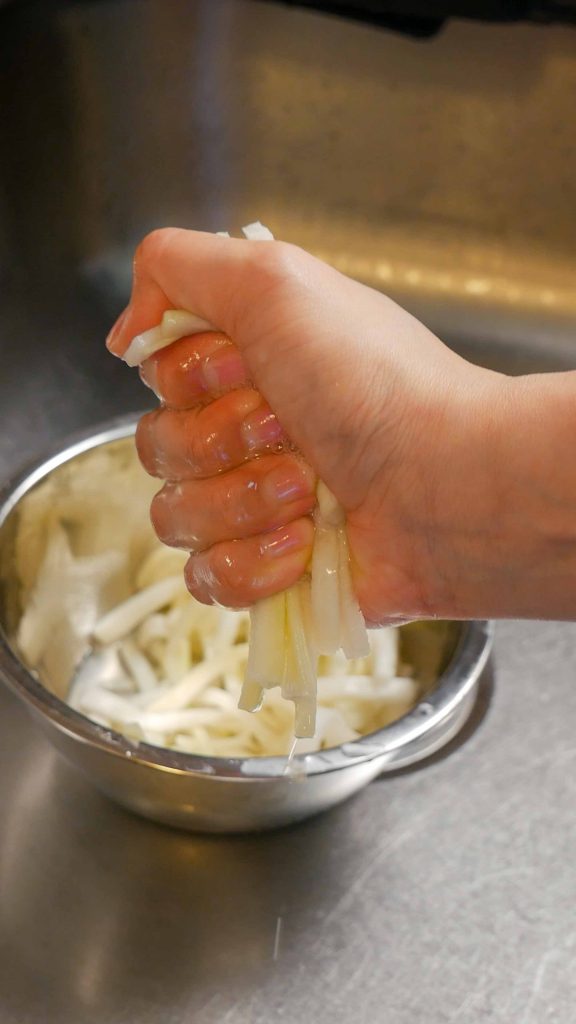
Step 4: Add the other ingredients
Transfer the radish into a clean mixing bowl. Toss in the garlic and scallions. Then add the fish sauce, gochugaru, 1 teaspoon sugar, 1/4 teaspoon salt, and toasted sesame seeds.

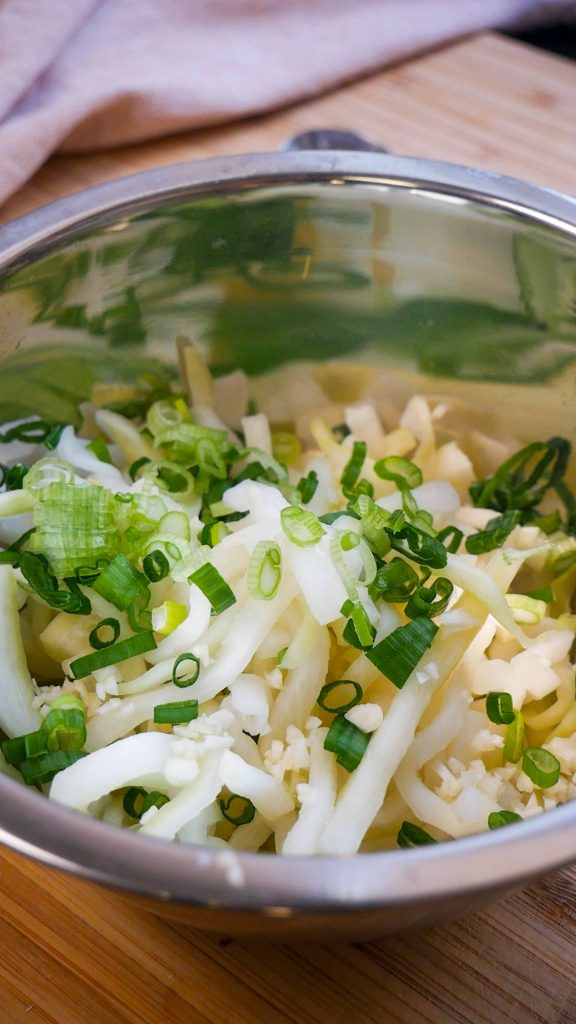
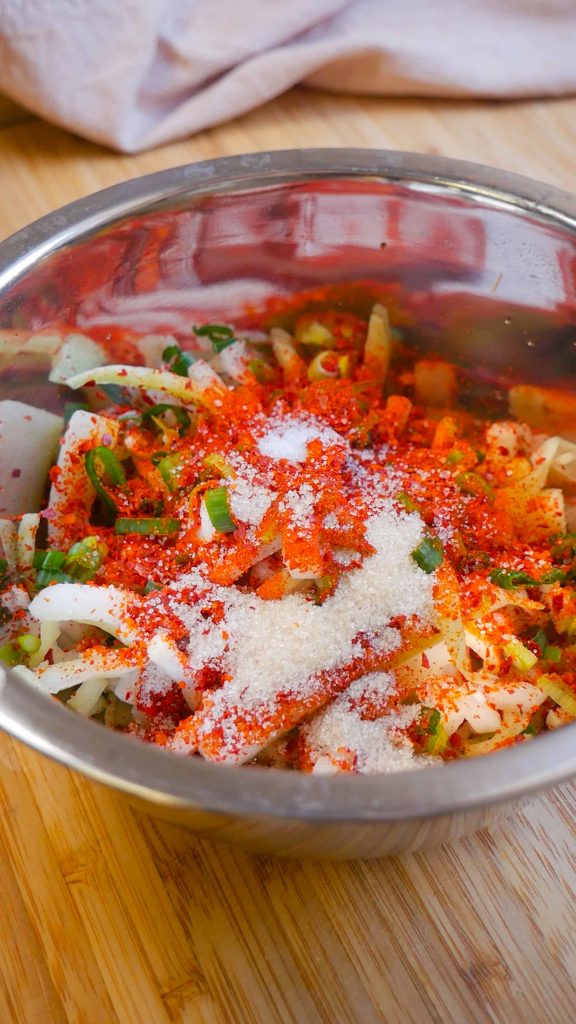
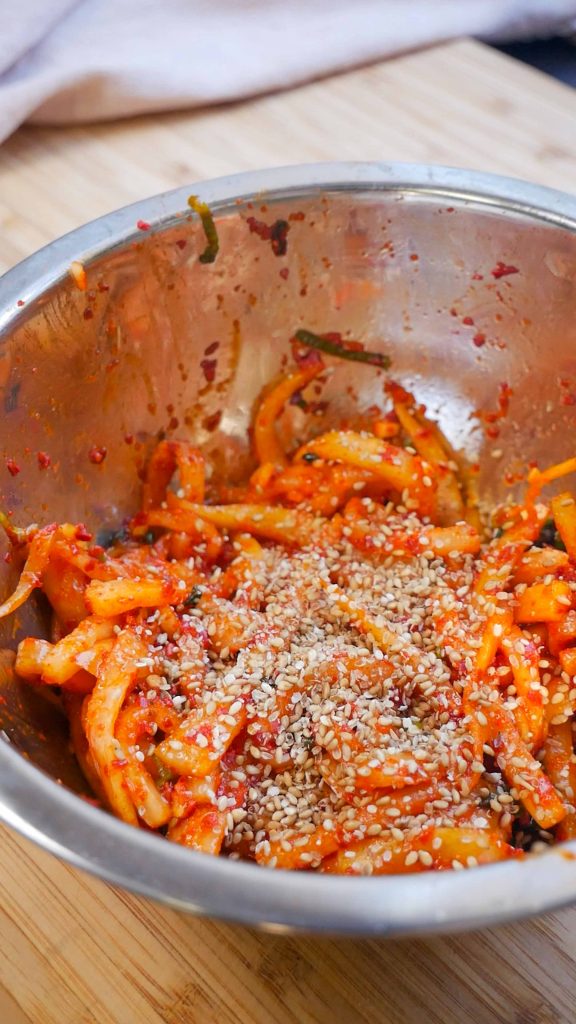
Step 5: Toss
Toss until well combined and thoroughly mixed.

Step 6: Serve
Serve and enjoy!

Preparation Tips for Korean Radish Salad
Here are some helpful tips for making the best homemade Korean radish salad every time:
- When buying fresh radishes, look for those that have smooth, clear skin with no bruises, discoloration, or tender and watery spots. They should feel firm when pressed with a little pressure, and also heavy for their size.
- Slice the radishes into uniform-sized pieces so they are consistent in taste and texture. Keep in mind that the thinner you slice them, the faster they will absorb the flavors. Thicker slices will require a longer time for the seasonings to penetrate the radish.
- Feel free to adjust the spiciness by modifying the amount of gochugaru added. For example, if you want a milder dish, reduce the amount of gochugaru added. Be sure to taste and adjust as you go!
- While this side dish can be enjoyed right away, I recommend waiting at least 30 minutes to allow the flavors to develop. You can also make this ahead of time – it will become tastier as it sits!

Frequently Asked Questions
How long does Korean radish salad last in the fridge?
With proper storage, Korean radish salad will last for up to one week in the fridge. Store the salad in a sealed airtight container to keep them fresh.
What is the difference between daikon and Korean radish?
Daikon radish and Korean radish are usually interchangeable for many recipes. They have a similar crisp texture but slightly differ in flavor. Daikon radish is sweeter and milder, while Korean radish is more peppery. In appearance, daikon is elongated with smooth white skin, while Korean radish is short and rounded, with the skin fading into green towards the top.
What do you eat Korean radish salad with?
Korean radish salad is best enjoyed as a side dish to accompany your main course. It’s most commonly served with bossam or Korean boiled pork belly. The spiciness and crunch of the radish salad complement the soft and tender pork belly. It’s also great with rice, noodles, salads, bowls, and more!
Can you eat Korean radish raw?
Yes, Korean radish is safe to eat raw! Enjoy it pickled, in a salad, or as a refreshing addition to sandwiches, noodles, and wraps. Keep in mind that Korean radish is peppery and the spiciness is most pronounced when raw.
How to know if radish is bad?
You would know if radish has gone bad if it has dark, tender, watery, or moldy spots in the skin. Spoiled radishes may also feel mushy and have a sour or foul odor.
Do I need to peel Korean radish?
Korean radish skin is completely edible however, for this recipe, it is best to be peeled.
How do you clean Korean radishes?
To clean Korean radishes, rinse them under cold running water. If it feels gritty or there is any visible dirt, you can scrub them using a vegetable brush or a clean kitchen cloth. Once done, pat the radishes dry before storage.

Looking for more easy and delicious vegetable side dish recipes?
Easy Spicy Asian Cucumber Salad Recipe — This Asian cucumber salad is a light and refreshing side dish that you can serve with any meal. While there are many variations of this cucumber salad, this recipe is a fusion of my Korean and Chinese cultures. It includes ingredients that were commonly found in my family’s pantry, like gochugaru and Chinese black vinegar.
Vietnamese Tomato Salad — This is a Vietnamese-style tomato salad that’s quick, easy, and perfect for the warmer weather. It has a nice balance of salty, sweet, spicy, and sour, and I love that you can make this in just 10 minutes! Since this salad helps to refresh your palate, it would also be perfect to enjoy during your potlucks and barbecues.
Quick Asian Pickled Cucumbers — Fresh, tangy, bright, and slightly sweet, this quick Asian pickled cucumber is a refreshing side dish for your main dishes. It cleanses the palate so well, and it tastes so fresh. Try to make it at home using only 5 ingredients and in just 15 minutes!
Brussels Sprouts with Shallot & Garlic Chips — Brussels Sprouts are a seriously underrated vegetable and when cooked right, they’re absolutely delicious! In this recipe, the crispy shallots and garlic chips complement the soft and tender texture of the Brussels sprouts which makes them a perfect appetizer or side dish to accompany almost any meal.
Chinese Cucumber Garlic — This Chinese-style garlicky cucumber salad is a staple recipe in my home and one that I think everyone should know how to make! It’s a simple yet delicious vegetarian side dish – savory, tangy, slightly sweet, and very garlicky!
Geotjeori Kimchi — Geotjeori or fresh kimchi is a delicious refreshing kimchi variety that comes together in less than half the time of regular kimchi! Compared to most kimchi that take a couple of days to prepare, this kimchi can be eaten right away, so you don’t have to wait.
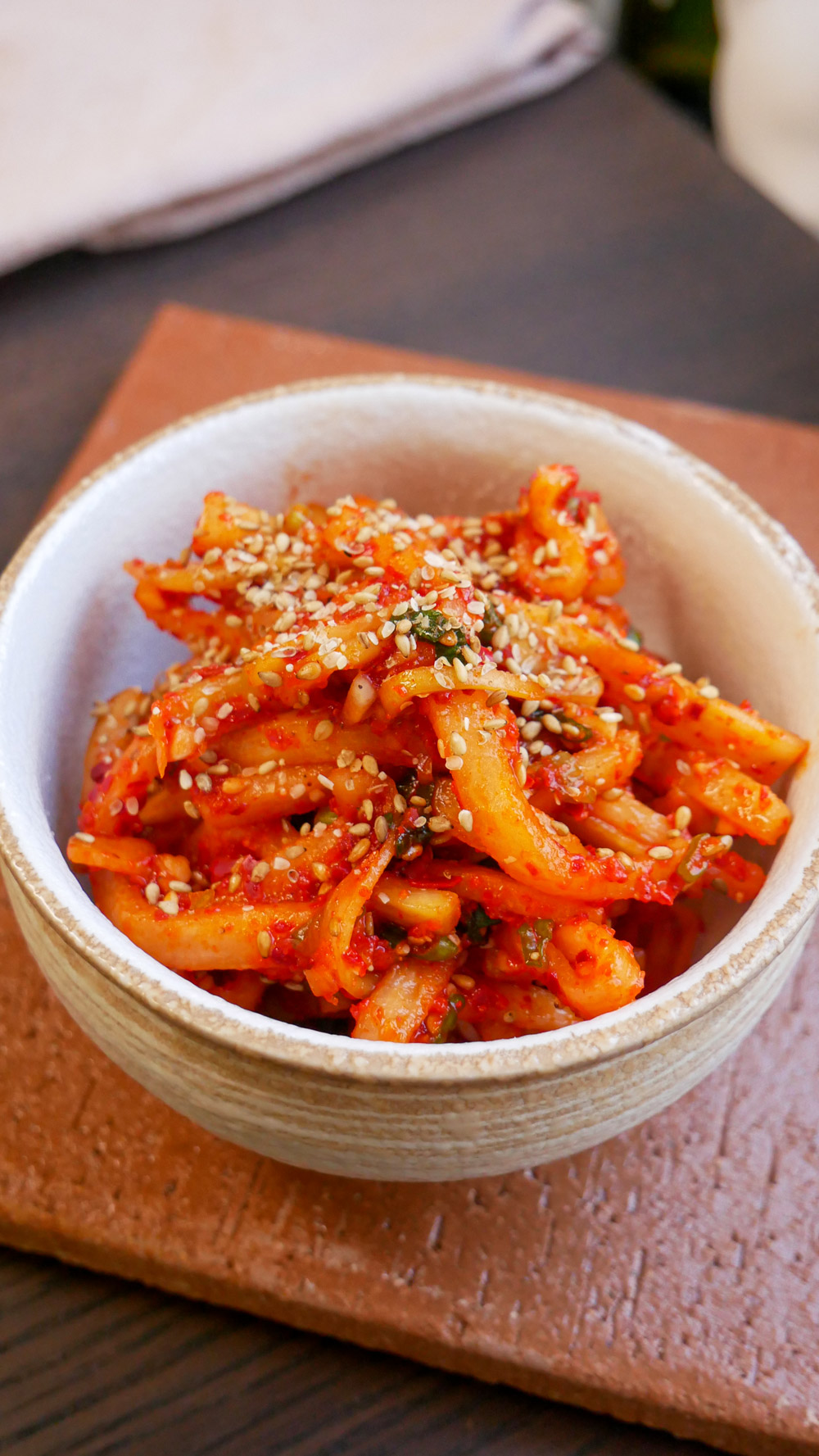
Korean Radish Salad Recipe – Musaengchae [무생채]
Ingredients
- 1 lb Korean radish or daikon radish
- 1 1/4 tsp salt divided
- 2 tsp sugar divided
- 1 garlic minced
- 1 scallion chopped
- 1 1/2 tbsp fish sauce
- 1 tbsp gochugaru Korean red pepper flakes
- 1 tsp white vinegar adjust to taste
- 2 tsp toasted sesame seeds
Instructions
- Wash and peel the Korean radish. Slice them into thin matchsticks, about 1/4 inch thick.
- Transfer the radish into a small mixing bowl. Add 1 teaspoon salt and 1 teaspoon sugar. Toss to combine well. Set aside for 15 minutes.
- After 15 minutes, you should see a pool of liquid at the bottom of the mixing bowl. Drain the radish then squeeze out the excess liquid. Be sure to work in batches so you get as much liquid out as possible.
- Transfer the radish into a clean mixing bowl. Toss in the garlic and scallions. Then add the fish sauce, gochugaru, 1 teaspoon sugar, 1/4 teaspoon salt, and toasted sesame seeds.
- Toss until well combined and thoroughly mixed.
- Serve and enjoy!
